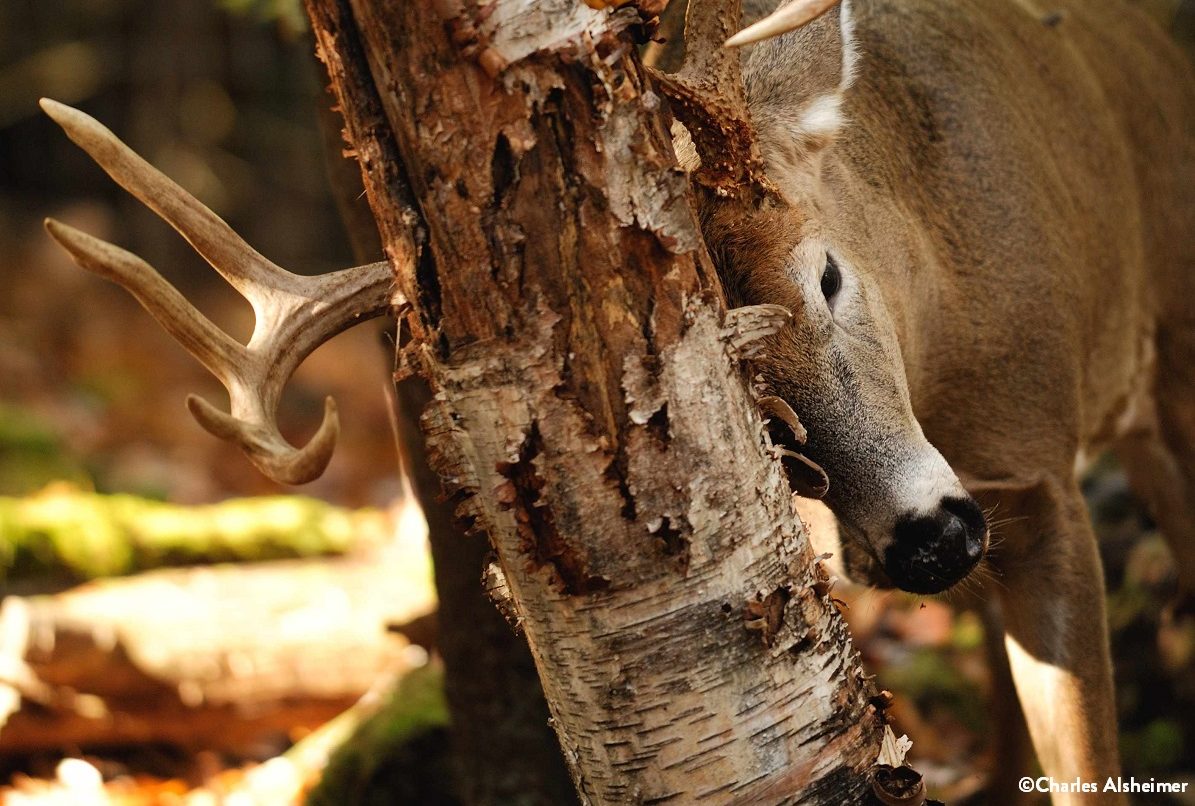September 15 – October 15
Throughout much of their northern range whitetails curtail their activity drastically during late September through mid-October. This is why hunters refer to this period as the October lull. It’s almost like they are resting up for the coming rigors of November’s rut. Does, on the other hand, seem to continue their normal movement patterns. With doe sightings high and buck sightings low, hunting the pre-rut period can be very frustrating. However, there is a bright side to hunting the mid to late September time period. During this time a few bucks may still be in bachelor groups. In many cases these bachelor groups will be made up of a dominant buck and one or two yearlings.
 Bucks spend much of their time bedded in the early season due to the warm temps and their heavy coats.
Bucks spend much of their time bedded in the early season due to the warm temps and their heavy coats.
Unlike the rut, when buck activity can be high throughout the day, deer activity during the pre-rut or early season, can be very sporadic. This is due to the warm temperatures that often occur during this time. Consequently, it’s no surprise that deer sightings are relatively low in early autumn. I refer to this as the “fur factor.” With a heavy fur coat and no sweat glands, a whitetail cannot tolerate heat and is forced to keep its daytime activity to a minimum. I’ve observed that both bucks and does often remain in one bed for up to 4 hours before rising to relieve themselves or move around when temperature are on the rise. Even when they do get up, they may only move a few yards before bedding again.
RELATED: Why the October Lull?
For the last 20 years deer biologist Wayne Laroche (Commissioner of Wildlife for Pennsylvania) and I have been involved in a study dealing with deer movement throughout autumn. Using much of today’s technology we’ve discovered that when air temperatures rise above 50-55 degrees in the North during September and October deer activity is significantly curtailed. As mentioned in my previous article, Hunting the Early Season Shift, hunting the last two hours of the daylight is the best option from late September through mid-October because the temperature should be dropping, causing deer to hit food sources after being bedded since dawn.
RELATED: 3 Must Use Weather Tools
During this period a whitetail’s world revolves around bedding and feeding. What rutting activity does occur amounts to bucks working scrape licking branches and making a few rubs. Their interest in does is nearly non-existent, unless the odd doe happens to cycle into estrus earlier than normal.
October 15 through December
When late October arrives the whitetail rut is born. Though it begins slowly it’s the most exciting time of year to be a deer hunter. By Halloween it’s not uncommon for testosterone fused bucks to double the amount of ground they cover. In some cases, their range will expand up to 2,000 acres by November 1st, a 1,000 acre or more increase from September 1st.
 Bucks will drastically expand their ranges during the rut while they search for hot does
Bucks will drastically expand their ranges during the rut while they search for hot does
In the North scraping will begin to be seen around prime food sources and travel corridors by early October. Near month’s end scraping behavior will explode and remain high until breeding kicks in. When working a scrape’s overhanging branch, a buck deposits scent from his nasal, preorbital and forehead gland. Once he’s done working the branch he will urinate over his tarsal glands leaving scent from both tarsal and interdigital glands in the bare earth beneath the branch. Both scraping and rubbing are the chief ways for bucks to telegraph their presence to other deer in the area.
RELATED: Understanding Scrape Behavior
By the end of October, rub sightings will be on the increase with each passing day. If an area has a good population of mature bucks, rubbing sign will be near peak during the first half of November. Around the first week in November, daytime buck sightings will begin ramping up. One aspect of the 20 year study project Wayne Laroche and I are conducting has to do with deer car collisions. An interesting discovery of this study is that the week either side of November’s full moon produces roughly twice as many deer car collisions as any other time of year. In my book, Strategies for Whitetails I refer to this as the Rutting Moon, which is November 14th this year.

Based on what we’ve learned bucks will begin covering a lot of ground in early November. In farm country, if the doe population is high and has plentiful food, bucks may only cover 1-2,000 acres. But in remote regions, where doe numbers are low, telemetry studies have shown that rut-crazed bucks can cover 4,000 or more acres as they roam looking for a doe to breed.
By mid-November breeding will intensify and go full-throttle through Thanksgiving with bucks locked on to estrous does. Commonly known as the rut’s lock down, buck sightings will be tough to come by until the tail end of November, unless you have a hot doe near your stand. The preferred hunting strategy now will be to concentrate on known concentrations of does and prime food sources.

Once December 1st arrives, about 90% of the breeding will be complete. Stressed from the rigors of the rut bucks now move into what I call the recovery stage. Rather than searching for estrus does many bucks will cover little ground and spend most daylight hours bedded until a few hours before nightfall, when they gravitate to prime food sources. From this point until antler casting (January – March) food drives whitetails, with the last two hours of the daylight being the prime time to see deer.







